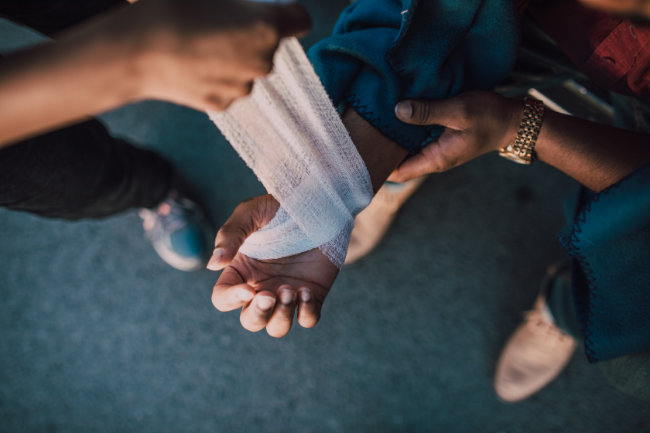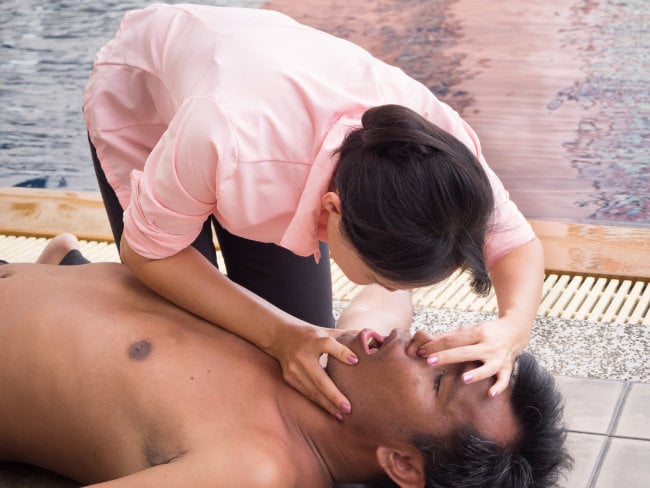When a crisis hits, medical professionals aren’t always on the scene to administer CPR or first aid right away. In many cases, a willing bystander stepping in to provide aid can make the difference between life and death for the emergency victim. Medical professional or not, just one ready and able person can save a life.
Unfortunately, many people hesitate to administer emergency aid because they fear potential consequences. Fears of causing further harm or endangering oneself are common — but they’re also often unfounded.
It’s important to understand where these fears come from and why they’re unfounded so we can push past them and take life-saving action anyway.
Here are four common myths about administering CPR and why you shouldn’t let them stop you when you need to save a life.
CPR Myth: Rescue Breathing Is No Longer Necessary
To be fair, this myth is partially based in reality. It’s true that the AHA recommends that those who aren’t trained in CPR and first aid or who don’t feel comfortable administering rescue breathing stick to compression-only CPR. And for many people, giving rescue breathing can seem uncomfortable and even unsafe.
However, some emergency circumstances such as drowning, choking, or a severe asthma attack may still require rescue breathing to save the person’s life. While performing compression-only CPR is still much better than doing nothing, the best thing you can do is learn how to safely administer rescue breathing in case the need should arise.
Knowledge is power. The more prepared you are to act in an emergency, the more confident you’ll feel in your ability to save a life.
CPR Myth: You Can Hurt the Person If You Do It Wrong
Perhaps one of the biggest fears that stops bystanders from administering CPR is the fear of messing up and injuring the person even more. For example, you may have been told that if you perform chest compressions incorrectly, you could break the person’s ribs.
But think about it this way: If no one administers CPR, that person will most likely die. You can’t make their condition any worse than that. But if you perform CPR to the best of your abilities, you may be able to keep them alive until medical professionals arrive.
Remember, when administering CPR, your objective is to save a life. Even if an injury results from you performing CPR, it’s better than not doing anything and just letting the person die.
CPR Myth: Only Attempt CPR If Your Certificate Hasn’t Expired
Sometimes people confuse a CPR certification with a medical license in the sense that if their certification has expired, they believe they are no longer qualified to administer CPR and first aid. But that’s not true.
Being CPR certified simply means you’ve been trained to safely and effectively administer CPR so you can save a life. While staying up-to-date on best practices is always ideal, your knowledge and skills aren’t going to vanish the day your certification expires.
If you’re physically able to perform CPR, do it — don’t stop to think about whether your certification needs renewing.
First Aid Myth: You Can Contract a Disease by Performing CPR
If there is blood on the person or on the scene, or if you don’t know the individual you’re administering CPR to, there may be a fear of contracting a disease by performing CPR. However, if you have equipment such as gloves and a one-way rescue mask with you, these protective barriers will keep any pathogens from passing from the victim to you.
This is why we strongly encourage everyone who completes CPR training to also purchase protective equipment and keep it neatly stored in your home and vehicle just in case you need to save a life.
If you don’t have any protective equipment or if you’re still worried about contamination, you can perform hands-only CPR. Research has shown that, especially with adult victims and in the first few minutes, hands-only CPR is just as effective as full CPR. Remember: some CPR is better than no CPR in sustaining life until emergency personnel arrives, and hands-only CPR will still benefit the patient.
Imperfect CPR Can Still Save a Life
Too often, people hesitate to give life-saving CPR because they’re afraid of doing something wrong or that they’re not qualified. But any effort to save a life in an emergency is better than none at all.
The best way to overcome such fears and confidently offer emergency aid is to prepare for emergency situations in advance. Getting CPR certified is an important action we can all take to keep ourselves and the people around us safer.
Need to get your team or employees certified in CPR and first aid? Learn more about our group and remote-staff CPR certification programs.


